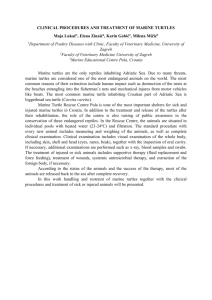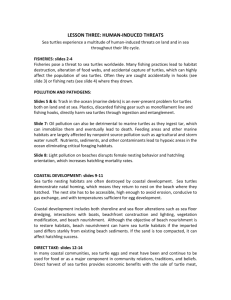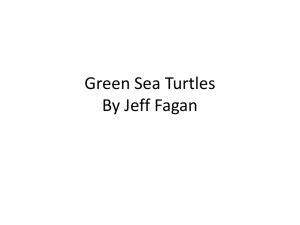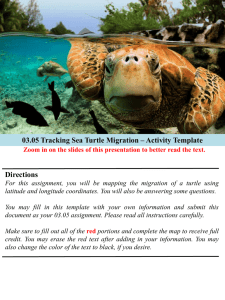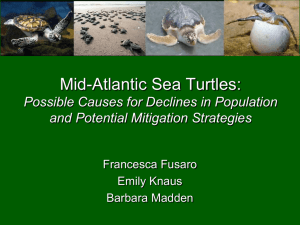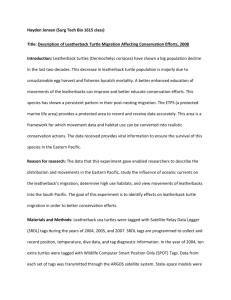Module 03 Study Guide
advertisement
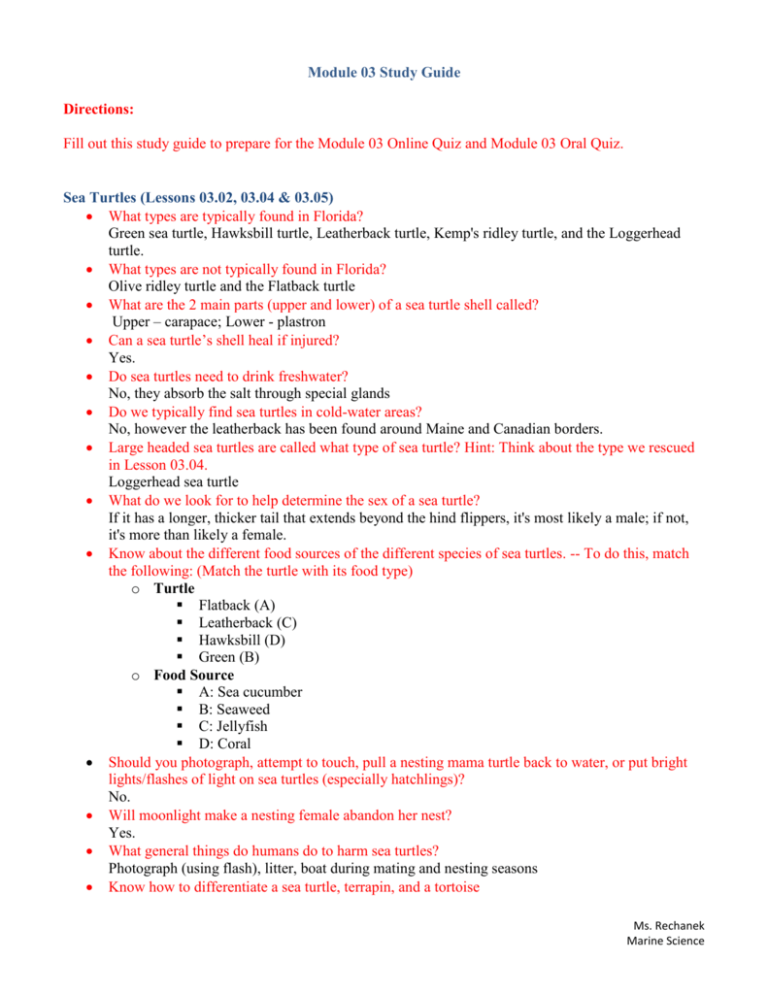
Module 03 Study Guide Directions: Fill out this study guide to prepare for the Module 03 Online Quiz and Module 03 Oral Quiz. Sea Turtles (Lessons 03.02, 03.04 & 03.05) What types are typically found in Florida? Green sea turtle, Hawksbill turtle, Leatherback turtle, Kemp's ridley turtle, and the Loggerhead turtle. What types are not typically found in Florida? Olive ridley turtle and the Flatback turtle What are the 2 main parts (upper and lower) of a sea turtle shell called? Upper – carapace; Lower - plastron Can a sea turtle’s shell heal if injured? Yes. Do sea turtles need to drink freshwater? No, they absorb the salt through special glands Do we typically find sea turtles in cold-water areas? No, however the leatherback has been found around Maine and Canadian borders. Large headed sea turtles are called what type of sea turtle? Hint: Think about the type we rescued in Lesson 03.04. Loggerhead sea turtle What do we look for to help determine the sex of a sea turtle? If it has a longer, thicker tail that extends beyond the hind flippers, it's most likely a male; if not, it's more than likely a female. Know about the different food sources of the different species of sea turtles. -- To do this, match the following: (Match the turtle with its food type) o Turtle Flatback (A) Leatherback (C) Hawksbill (D) Green (B) o Food Source A: Sea cucumber B: Seaweed C: Jellyfish D: Coral Should you photograph, attempt to touch, pull a nesting mama turtle back to water, or put bright lights/flashes of light on sea turtles (especially hatchlings)? No. Will moonlight make a nesting female abandon her nest? Yes. What general things do humans do to harm sea turtles? Photograph (using flash), litter, boat during mating and nesting seasons Know how to differentiate a sea turtle, terrapin, and a tortoise Ms. Rechanek Marine Science Sea turtles: aquatic, have flippers, omnivores Terrapin: semi-aquatic, can live in brackish water, usually small Tortoise: almost exclusively land dwelling, elephant-like feet What are the general mating seasons for loggerhead sea turtles? The mating season for loggerhead sea turtles is usually through March to early June. Positive Human Impact (Lesson 03.06) What are the three types of positive human impact efforts being utilized to protect the environment? Beach renourishment, replanting of sea grasses, and ecotourism, and coastal cleanup. What are the differences between the three types of human efforts being put forth to protect marine environments? People are starting to do coral propagation, planting of sea grasses, and beach renourishment. Would the depletion of non-renewable resources, burning of fossil fuels, and oil spills have positive or negative effects on the environment? A positive effect because their habitats won’t be destroyed and the Earth would become a much cleaner place to live. Would beach re-nourishment, replanting of sea grasses, and ecotourism have positive or negative effects on the environment? It has mostly positive effects because it helps traps the sand and keeps it in one place but it can also be negative when unnatural sources are used to replenish the beaches. Why are sea grasses important to an estuary ecosystem? List all of the reasons. Sea bottom, provide food and habitat for many marine organisms, maintain water quality and support local economies. What benefits do mangrove forests provide to the environment? List all of the reasons. Mangroves absorb and recycle various organic materials and nutrients, serve as nursery areas for fishes, crustaceans, and shellfish. They also provide food for a multitude of marine species. When we replant sea grasses and mangrove trees, which type of positive human impact effort, would we consider this to be: Conservation, preservation, or restoration? Restoration. Be able to explain the purpose and role of the Endangered Species Act (ESA) in the preservation of threatened and endangered organisms. Be sure to read the ESA facts sheet on the ESA link, also. Federal agencies start programs to conserve important habitats, create an umbrella of laws against hunting for endangered species, and match contributions from individual states towards the project. The United States Fish and Wildlife Service (FWS) and the National Marine Fisheries Service (NMFS) enforce the Endangered Species Act. Sandy Beach (Lesson 03.07) Know the 3 main zones of the sandy beach. Surf zone, intertidal zone, backshore zone The middle zone is sometimes separated into what two smaller zones? Dune zone, maritime forest zone Know some major organisms that live in each of the zones. -- To do this, match the following: (Match the organism with the zone) o Zone Intertidal (D) Backshore (A) Ms. Rechanek Marine Science Surf Zone (C) Dunes (B) o Organism A: Amphipods B: Beetles C: Pompano D: Sand mussel What are the 3 forces of nature that are constantly shaping and forming the beach areas? Waves, wind, What is the major difference in the sea floor between Caribbean waters and the northeast part of the US? Hint: This would make water seem bluer and clearer. There is less pollution in the water. What is the first plant to grow and start dune development? Sea oat? Erosion Control Methods (Lesson 03.08) What are the four main erosion control methods (know the main pros and cons of each) Breakwaters, planting dune grasses, beach nourishment, jetties Ocean Pollution & Oil (Lesson 03.09 & 03.11) Know main pollutants and the problems they cause. -- To do this match the following: (Match the pollutant with its problem) o Pollutant Oil spills (C) Plastic rings (B) Balloons (A) o Problem A: Clog stomachs B: Choke animals as they grow (think about the movie Happy Feet) C: Smother animals on shore Know basic (common sense) ways to protect marine environment. Ex: Clean up after yourself; pick up trash and litter, Where does most of the oil in the ocean come from? The oil in the ocean mostly comes from oil spills off of barges. What is the worst form of marine pollution? oil Oil Spill Clean Up Methods Identify in pictures and define the following oil spill control methods: o Skimmer: A skimmer is a device for recovering spilled oil from the water's surface. Skimmers may be self-propelled, used from shore, or operated from vessels. The efficiency of skimmers is highly dependent upon conditions at sea. In moderately rough or choppy water, skimmers tend to recover more water than oil. Three types of skimmers--weir, oleophilic and suction--are described here. Each type offers advantages and drawbacks depending on the type of oil being recovered, the sea conditions during cleanup efforts, and the presence of ice or debris in the water. Ms. Rechanek Marine Science o Boom: Containment booms are used to control the spread of oil to reduce the possibility of polluting shorelines and other resources, as well as to concentrate oil in thicker surface layers, making recovery easier. In addition, booms may be used to divert and channel oil slicks along desired paths, making them easier to remove from the surface of the water. o Dispersant: Dispersing agents, also called dispersants, are chemicals that contain surfactants and/or solvent compounds that act to break petroleum oil into small droplets. In an oil spill, these droplets disperse into the water column where they are subjected to natural processes, such as waves and currents, which help to break them down further. This helps to clear oil from the water's surface, making it less likely that the oil slick will reach the shoreline. o Sorbent: Sorbents are insoluble materials or mixtures of materials used to recover liquids through the mechanism of absorption, or adsorption, or both. Absorbents are materials that pick up and retain liquid distributed throughout its molecular structure causing the solid to swell (50 percent or more). The absorbent must be at least 70 percent insoluble in excess fluid. Adsorbents are insoluble materials that are coated by a liquid on its surface, including pores and capillaries, without the solid swelling more than 50 percent in excess liquid. To be useful in combating oil spills, sorbents need to be both oleophilic (oil-attracting) and hydrophobic (water-repellent). Although they may be used as the sole cleanup method in small spills, sorbents are most often used to remove final traces of oil, or in areas that cannot be reached by skimmers. Sorbent materials used to recover oil must be disposed of in accordance with approved local, state, and federal regulations. Any oil that is removed from sorbent materials must also be properly disposed of or recycled. How do we prevent oil spills? Next Steps: Now it’s time to complete your Module 03 Oral Quiz! Please set up an appointment here for your oral quiz: http://bit.do/oralquiz. You can also call/text me to set up an appointment. Remember that before you complete the online quiz, we will need to complete the oral quiz for this module. Ms. Rechanek Marine Science


